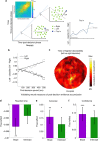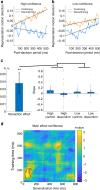Confidence drives a neural confirmation bias
- PMID: 32457308
- PMCID: PMC7250867
- DOI: 10.1038/s41467-020-16278-6
Confidence drives a neural confirmation bias
Abstract
A prominent source of polarised and entrenched beliefs is confirmation bias, where evidence against one's position is selectively disregarded. This effect is most starkly evident when opposing parties are highly confident in their decisions. Here we combine human magnetoencephalography (MEG) with behavioural and neural modelling to identify alterations in post-decisional processing that contribute to the phenomenon of confirmation bias. We show that holding high confidence in a decision leads to a striking modulation of post-decision neural processing, such that integration of confirmatory evidence is amplified while disconfirmatory evidence processing is abolished. We conclude that confidence shapes a selective neural gating for choice-consistent information, reducing the likelihood of changes of mind on the basis of new information. A central role for confidence in shaping the fidelity of evidence accumulation indicates that metacognitive interventions may help ameliorate this pervasive cognitive bias.
Conflict of interest statement
All authors declare no competing interests.
Figures




References
-
- Pomerantz EM, Chaiken S, Tordesillas RS. Attitude strength and resistance processes. J. Pers. Soc. Psychol. 1995;69:408. - PubMed
-
- Park, J., Konana, P., Gu, B., Kumar, A. & Raghunathan, R. Confirmation bias, overconfidence, and investment performance: Evidence from stock message boards. McCombs Res. Pap. Ser. No. IROM-07-10 (2010).
-
- Nickerson RS. Confirmation bias: a ubiquitous phenomenon in many guises. Rev. Gen. Psychol. 1998;2:175–220.
-
- Lord CG, Ross L, Lepper MR. Biased assimilation and attitude polarization: The effects of prior theories on subsequently considered evidence. J. Pers. Soc. Psychol. 1979;37:2098.
Publication types
MeSH terms
Grants and funding
LinkOut - more resources
Full Text Sources

